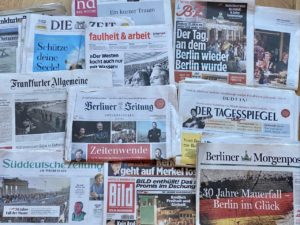I. Overview
The focus of this lesson is the issues regarding the cultural heritage of the communist regime, such as monuments and other architectural sites, the variety of attitudes towards this during the transition period, and possible solutions to these issues. The students will be advised to use different types of historical sources, as well as a variety of perspectives on the subject at hand.
II. Students’ age
Upper secondary level: 9th – 10th grades
III. Objectives
The students will be expected to:
- Develop their knowledge and critical understanding of the complexities related to the monuments of the communist regime during the transition, and people’s attitudes towards them.
- Analyse various types of historical sources to investigate different viewpoints.
- Discuss and express their own opinions using specific facts.
- Develop teamwork skills.
IV. Key concepts
Cultural heritage, civil society, collective memory.
I. Key question
What were people’s responses to the totalitarian regime monuments in Bulgaria after 1989?
VI. Prior knowledge
Knowledge about the period 1945-1989 in Bulgaria.
VII. Step-by-step description of the lesson
Duration: 90 minutes (2 X 40 minutes)
The learning activities are intended to last roughly 90 minutes. The lesson comprises two parts: in the first one, the students work with resources providing information about the Soviet Army Memorial in Sofia1 (and different perspectives on it), and the second part will be a discussion among the students.
ACTIVITY 1: Work with historical sources
Step 1: Split the class into small groups of 3-4 students.
Step 2: Students work with sources on the Soviet Army Memorial in Sofia and on two examples of attitudes towards monuments (see APPENDIX – WORKSHEET). One of the examples is the wrapping of the Reichstag in Berlin, and the second relates to the worldwide movement during the summer of 2020 to demolish various monuments that commemorate controversial historical figures (colonialists, slave traders, Confederacy heroes from the US Civil War, etc.).
In the course of the lesson, the students compile a list of different points of view regarding the monument to the Soviet Army in Sofia, and the group then determines the material that results from the analysis of individual history sources.
The students also become familiar with the two examples and can explore them in more depth or find similar examples.
Duration of steps 1 and 2: 40 minutes
ACTIVITY 2: Role-play – discussion of points for and against the monument in two groups
Step 3: Split the class into two large groups.
Step 4: The first group believes that the Soviet Arm monument in Sofia must be preserved. The second group is against this argument. Both groups will discuss and articulate at least three arguments in support of their side of the argument. These arguments are written on three separate sheets (coloured sheets or sticky notes can also be used). These arguments are mostly based on the students’ work with the history sources during Step 2. Other arguments might also be presented as long as they are supported by facts.
Duration: 15 minutes
Step 5: The teacher stages a discussion between the two groups. The written arguments are placed on a board (or on a wall) facing away from the students. The arguments of the two groups are presented one at a time, turning the respective sheets face up. Each time, different students from each team present the arguments within a two-minute time limit. The listening team can pose a question about the arguments being presented, to which the presenting team should respond. It is important that as many students as possible get involved in the discussion. It is essential to avoid repetition of the arguments. Students should not interrupt each other. Questions can be asked after an argument has been presented. After both groups have presented their arguments, the teacher makes a summary of both positions (this can instead be done by a special jury of students, which monitors the course of discussion). The presentations could be ranked by means of a student vote as well.
Duration: 25 minutes
Possible follow-up:
Project work: The students conduct research into the monuments to the totalitarian regime in the places they live. The final result of this work will be a file containing a description of the monument (including photos taken by the students) and a brief history of its creation. The contemporary condition of these monuments and whether or not the citizens agree on their future shall also be reflected in the file.
- Materials and tools, required equipment, handouts
- Annex (handouts examples) /Appendix
The story was captured in the short documentary In Step with The Time directed by Anton Partalev, featuring anonymous interviews with the artists of Destructive Creation and various representatives of pro-Russian organizations in Bulgaria. The film came second place at the 2013 Festiwal IN OUT (In Out Festival) in Poland.
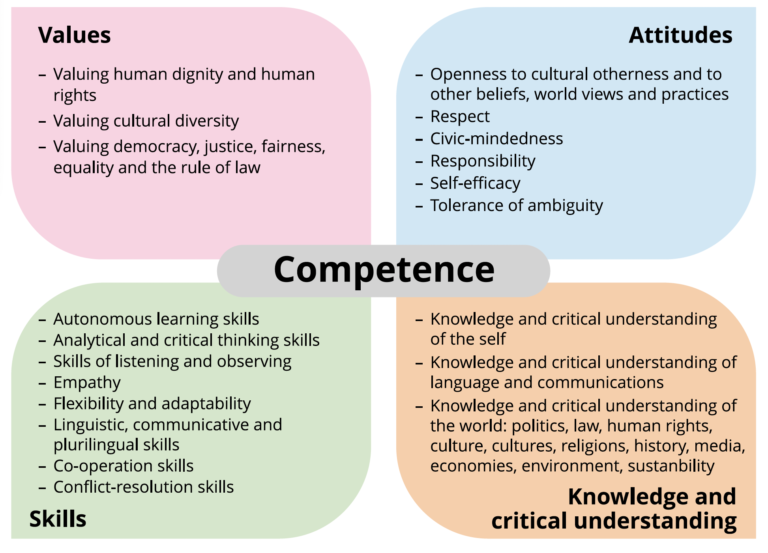
APPENDIX
Worksheet with different views
1. Chronology
December 13th, 1941 – The 25th Ordinary National Assembly of Bulgaria declares war on the United States and Great Britain. Diplomatic relations with the Soviet Union persist.
August 26th, 1944 – Bulgaria declares neutrality once again. An order is issued to disarm German army units on Bulgarian territory. Ivan Bagrianov’s government resigns, and attempts begin to reinstate a new cabinet.
August 29th, 1944 – The government orders the withdrawal of Bulgarian troops from Macedonia.
September 2nd, 1944 – Led by Konstantin Muraviev, the legal opposition forms a new cabinet. (Bulgarian Agrarian Popular Union – Vrabcha 1).
September 4th, 1944 – At 6am, German military units capture the headquarters of the Bulgarian occupation corps in Niska Banya (Serbia).
September 4th, 1944 – Muraviev makes an official government announcement on the radi;, “complete and unimpeachable neutrality”.
September 5th, 1944 – At 7am, the USSR declares war on Bulgaria. At 10.45 pm, the Bulgarian government, in the presence of its regents, decides to sever diplomatic relations with Germany and seek a truce with the USSR. September 6th, 1944 – The government decides to declare war on Germany, taking effect at 6pm on September 8th.
September 9th, 1944 – The Fatherland Front, comprising communists, the leftwing splinter group of the Agricultural Party, Social Democrats and the right-wing Zveno Political Circle, launch a coup d’état and seize power, forming a coalition government led by Kimon Georgiev.
September 1944 – May 1945 – Bulgaria takes part in the final stage of the war against Germany.
February 10th, 1947 – The peace treaty with Bulgaria is signed in Paris.
December 1947 – Soviet troops, stationed since September 1944, leave Bulgarian territory.
1947-1954 – The so-called “Goryan movement”, a resistance movement of peasants who are against the imposition of the communist regime in Bulgaria, takes place.
September 7th, 1954 – The Soviet Army Memorial is unveiled in the centre of Sofia.
November 5th, 1957 – The “Alyosha” monument is unveiled in Plovdiv.
1992 – The Sofia Municipal Council decides to remove the mausoleum of Georgi Dimitrov from the city centre.
1993 – The Sofia Municipal Council, dominated by the right-wing Union of Democratic Forces (UDF), decides to remove the monument to the Soviet Army.
2010 – An Initiative Committee for the dismantling of the Soviet Army Memorial is established.
2. The Soviet Army War Memorial in Sofia
2a) The central monument of the war memorial, 1970.
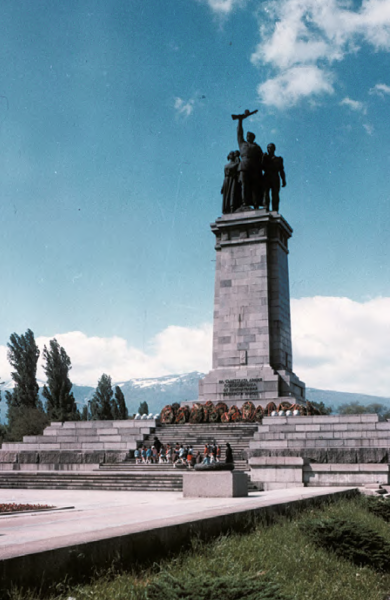
Source: https://bit.ly/362T8gS. Photo by Bin im Garten, under a CC BY-SA 3.0 license
2b) The sculptural composition on the eastern facade of the monument. “October 1917” on a drawing by the painter Boris Angelushev, sculpted by Lyubomir Dalchev.
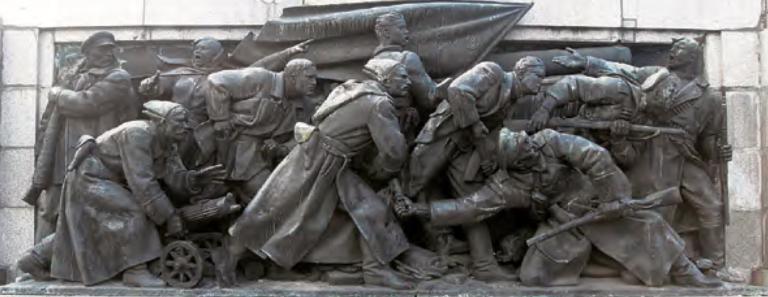
Source: https://bit.ly/3hUrrJU. Photo by Ferran Cornellà, under a CC BY-SA 3.0 license
2c) Western facade group composition titled “Fatherland War”, created by Vassil Zidarov and his team.
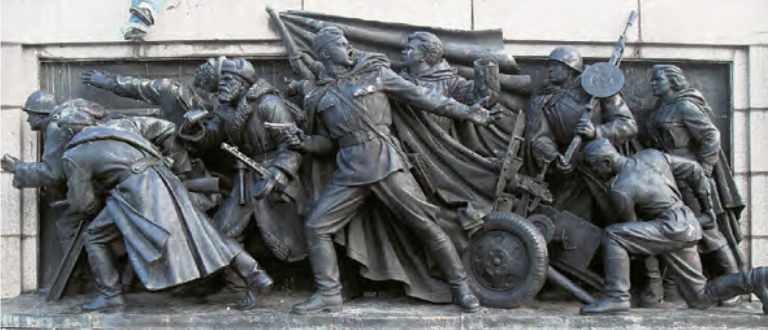
Source: https://bit.ly/37l3utv. Photo by Ferran Cornellà, under a CC BY-SA 3.0 license
2d) Southern facade group composition titled “The Homefront”, created by Petar Doichinov and his team.
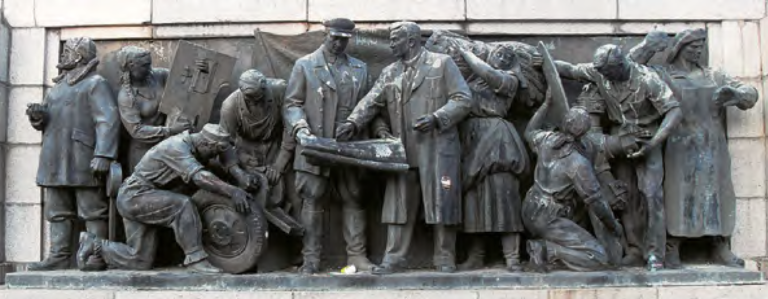
Source: https://bit.ly/3pMsv6T. Photo by Ferran Cornellà, under a CC BY-SA 3.0 license.
3. Ten million lev for the most expensive monument in our country: the Soviet Army war memorial
The monument works began in June 1952. “The foundations are being laid at the moment. The sculptural work is going well.” In the 1953 draft capital investment plan, the war memorial was given a price tag of Lev 10 million “for its final completion”, according to documents. Whether this was the entire memorial budget, or if the money only covered the work to complete is unclear. What is certain is that the memorial was ready for unveiling in 1954, taking place on September 7th, commemorating the 10th anniversary of the “people’s republic”.
In 1993, the Sofia Municipal Council, dominated by the UDF group, decided to remove the memorial. At this point, however, the attempts to implement the solution failed to garner strong public support and came to a halt.2
4. The first skaters in Sofia – late 1980’s – early 1990’s

Photo by Martin Mladenov, rights reserved.3
5. The first techno music parade in Sofia, the summer of 1999
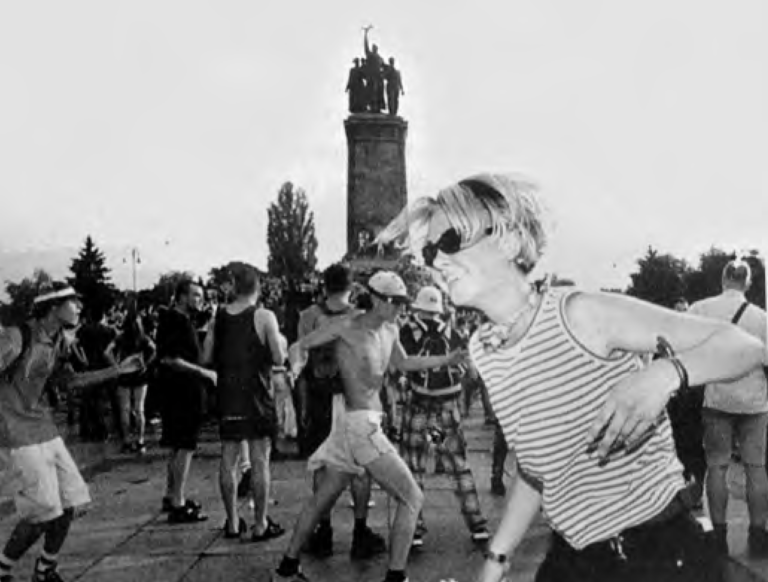
Credits: „Lik“ weekly, issue 5, 1999, rights reserved.
6. Initiative committee for removal of the memorial
In September 2010, an initiative committee was set up to dismantle the Soviet Army Memorial. The committee was based on the opinion that the monument was built in honour of an army that entered Bulgarian territory for no justifiable reason as a result of a war declared unilaterally against Bulgaria. Thus, from an international legal perspective, the Soviet Army was acting as an aggressor rather than a liberator. According to the committee, the monument paraded the Communist Party’s final victory over the “Goryan movement”.
The committee staged several events in front of the monument that made clear their request for its dismantling: November 9th 2010 – an event under the slogan “The Berlin Wall fell, the occupier’s monument stands!”; January 9th 2011 – a rally raising placards around the monument; April 2nd 2011 – an event under the slogan “Let us celebrate an urban space free of lies!”; November 9th 2012 – “The wall has fallen, the monument stands.”
7. The Soviet Army Memorial as a stage for political art and protest
7a) “Keeping up with the times”
On June 17th, 2011, the figures of the composition on the west side of the memorial were spray-painted as American comic and pop culture characters (from left to right): the Mask, the Joker, the Werewolf, Santa Claus, Superman, Ronald – the McDonald’s clown, Captain America, Batman’s assistant Robin, and Wonder Woman. The flag held by one of the figures was painted as the Stars and Stripes, and under the group of figures a caption was sprayed reading, “In step with the times”.
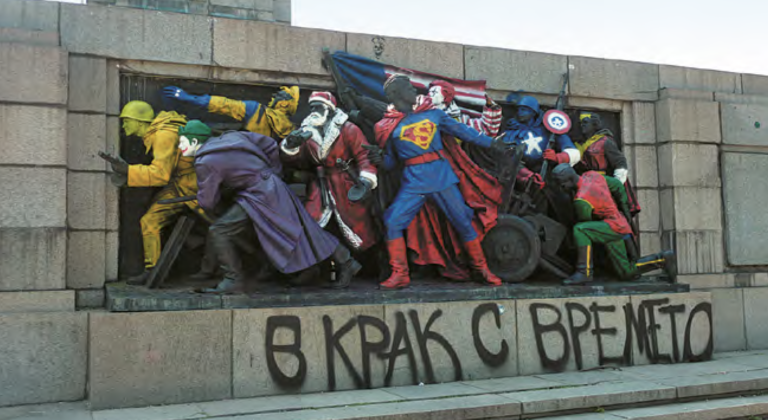
Source: https://commons.wikimedia.org/w/index.php?curid=15545141. Photo by Ignat Ignev, under a CC BY 3.0 license.
7b) Transforming the Memorial into a comic
Today, this fixation with monuments is made lighter perhaps only by the Destructive Creation group and their followers. In 2010, their work “In step with the times” replaced the images of Russian soldiers from the Soviet Army Memorial with popular comic book characters. Compared to everything else that the official art institutions have to offer, this creation can easily claim to be the purest manifestation of postmodernism in our country: it is a combination of poking fun at the institutions, irony, pop art, allegory, instrumentalising pop culture images, etc. These are all directions pursued by contemporary art. What it most significantly represents is a critique of what we are used to taking for granted. The ease with which the images of superheroes matched the faces and figures of the Soviet liberators was among the most astonishing revelations of this work. It thrust into the spotlight a long-hidden truth – that so-called “socialist realism” and comics used the same techniques. A key difference between them also emerged: socialist realism stripped the life force of colours off its images, and in so doing deprived the viewers of the visual world’s simplest pleasure, instead instilling into them feelings of fear and respect.4
7c) “Bulgaria apologizes”
On August 21st, 2013, the Soviet Army Memorial in Sofia was once again covered in paint overnight again, this time entirely in pink and accompanied by inscriptions in Czech and Bulgarian: “Bulharsko se omlouvá!!!” and “Bulgaria apologises!!!“ The other sides of the monument was covered in appeals like “C’mon apologise” and “Prague’68”. This was obviously an apology to the Czechs, commemorating the anniversary of the Prague Spring suppression in what was then Czechoslovakia.

Source: https://commons.wikimedia.org/w/index.php?curid=27812813. Photo by Ignat Ignev, under a CC BY-SA 3.0 license.
7d) “Glory to Ukraine”
On February 23rd, 2014, the memorial was covered overnight with inscriptions such as “Glory to Ukraine” (in Ukrainian) and “Kaputin” (a word play with Vladimir Putin’s name and kaputt, the German for broken or shattered) with the flag of Ukraine painted above them. A central soldier and the flag above him were also painted in the Ukrainian colours of blue and yellow. This was meant to express solidarity with Ukraine after weeks of heavy, violent anti-government protests in Ukraine, defending the country’s pro-European orientation.
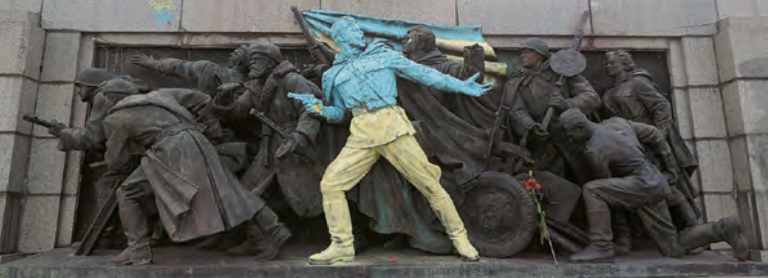
Source: https://bit.ly/3HXJlGr. Photo by Vassia Atanassova — Spiritia, under a CC BY-SA 3.0 license.
7e) “Keep your hands off Ukraine”
On March 2nd, 2014 the monument again met the dawn with a Ukraine-defending inscription, this time in response to the invasion of the Crimean peninsula by Russian troops, which read “Keep your hands off Ukraine”, and crossed out the original dedication, “To the liberating Soviet Army from the grateful Bulgarian people”.
On April 12th, a Polish soldier waving the Bulgarian flag and a Ukrainian soldier next to him were painted upon it. Below them an inscription in red said, “KATYN 5.III’40”. Another, white one under the memorial’s central statue read, “PUTIN, GO HOME!”
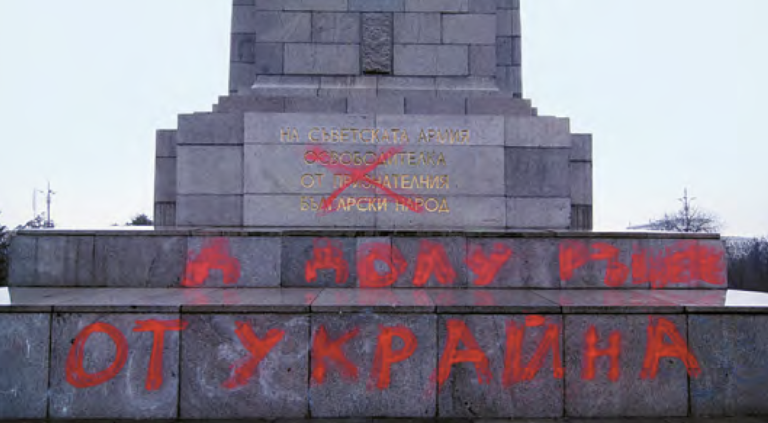
Source: https://commons.wikimedia.org/w/index.php?curid=31412988. Photo by Luchesar V. Iliev, under a CC BY-SA 3.0 license.
7f) “BSP are terrorists”
On July 1, 2017 (the July Mourning Day) the Memorial was found to have a new inscription reading “BSP (The Bulgarian Socialist Party) are terrorists”. Unlike the other cases of “defiling” (as the memorial’s advocates used to put it), this time the creativity of the intervention was critically limited. The inscription was obviously daubed in a hurry in red on the front plate of the monument, on top of the original “To the liberating Soviet Army from the grateful Bulgarian people”.
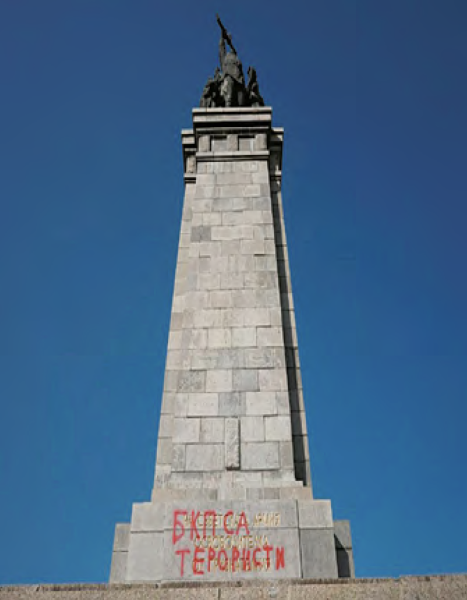
Source: https://www.ploshtadslaveikov.com/ bkp-sa-teroristi-glasi-pametnikat-na-savetskata- armiya/. Photo by Vesselin Borishev, Club Z, rights reserved.
8. Anger in Russia over the desecration of Soviet monuments in Bulgaria
The Soviet Army Memorial is the monument most often painted in Sofia.
On February 24, 2014, the Ministry of Foreign Affairs of Russia aired its indignation, stating: “The news of another case of vandalism of the Soviet Army Memorial in the centre of Bulgaria’s capital Sofia on the night of February 23rd has been met with deep indignation in Russia.” The Ministry sent a protest note to Bulgaria’s foreign affairs ministry requesting that they “conduct a thorough investigation into this hooligan incident, bring to justice those responsible for the illegal actions and take appropriate measures to put the memorial back to order”.5
9. “I’d give a good wallop to the one smearing the monuments.”
“The one smearing the monuments, I’d give him a good wallop,” admits the sculptor Krum Damyanov.
The creator of some of the top monumental art projects under the totalitarian regime admitted in an interview with Mariana Parvanova for the Monitor that he finds it difficult to choose between art and vandalism when it comes to the painting of monuments in our country: “It is a blend. As an artistic whim I find some of the outcomes amusing. I believe those have hit their mark. Dimitar Blagoev made a good Santa Claus. An element of modern art is present in the painted Soviet Army Memorial. But, in principle, I’d give the one smearing the monuments a good wallop. It’s complicated. I can’t judge. I don’t know whether or not it has a political effect.”
Damyanov is convinced of one thing: “What was done before us should not be destroyed. This means that the level of society has not moved at all. It destroys everything before it, the most important document – not a retelling of what was, but what one sees. That should not be destroyed. And that’s what intelligent nations don’t do. In Vienna there is a monument to the Soviet Army, in Berlin too. I will not forget Munich. I was walking around, and I saw in a glass box a torso shot with an assault rifle. Underneath the Germans had written: ‘Stop. Look. Think of those who did it, and those who shot it.” Everything is preserved there, from all periods. With us, the first is neither of great quality, nor is the second intelligent.”6
10. The Soviet Army Memorial will not be removed
The Soviet Army Memorial will not be removed from downtown Sofia, but its name is likely to be changed. This is the result of a poll conducted by Alpha Research, commissioned by Sofia Municipality. The poll was conducted in the period August-September 2014, with 400 people interviewed at home.
51% of interviewees asked about their attitude to the Soviet Army Memorial were positive about it. 30% believed the memorial should not be changed. Only 17% were unequivocally against its existence.
When asked what the future of the memorial should be, 66% of Sofia residents replied that it should remain as it is; 16% believed the memorial should be renamed, while 17% argued it should be dismantled.
How should the monument be altered? The majority of respondents believed its name should be changed to a memorial to the victims of World War II.7
Example 1 – The Wrapped Reichstag by Christo and Jean-Claude
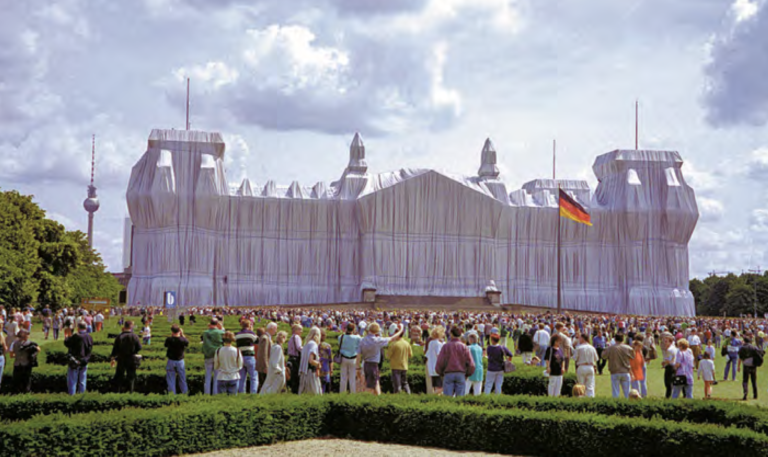
Photo by Michael, under a CC BY-NC-SA 2.0 license. More information available at: https://christojeanneclaude.net/artworks/wrapped-reichstag
On June 24th, 1995, Christo and Jeanne-Claude, with the help of 90 professional climbers and 120 installation workers, completed the wrapping of the Reichstag building in Berlin.
Having turned the proposal down three times, in 1994, after a 70-minute debate, the German parliament approved the project with 292 votes in favour and 223 against. A parliament debated a work of art for the first time in history.
In a 1977 interview, Christo said: “I used to wrap museums or art buildings. The Reichstag is a political site and it taught me a lot about the relationship between art and politics. […] Not the Reichstag itself, but the vicissitudes surrounding its wrapping set in motion a discussion about the significance of the building and its place in Berlin, Germany and history.8
Example 2 – Worldwide removal of monuments in the summer of 2020
In the summer of 2020, with the influence of the Black Lives Matter movement, the United States, and later Europe, began to see a process of revisiting several monuments to controversial historical personalities.
In Richmond, Virginia, a monument to Confederate Army General Robert Lee took on a new look: on June 8th, 2020, the image of George Floyd, whose death was caused by a police officer during his detention in Minneapolis and sparked mass protests against police violence, was projected onto its plinth.
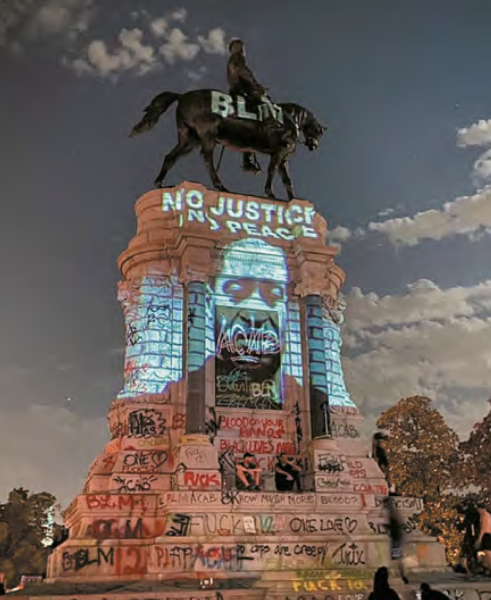
This is what the Robert E. Lee statue in Virginia looked like on May 5, 2020. Photo by Ron Frazier, under a CC BY 2.0. license.
In Bristol, UK, the statue of Edward Colston, a seventeenth-century slave trader, was toppled by BLM protesters and dumped in the harbor on June 7th, 2020, forcing the UK to reconsider how it should confront its racist history.
Colston, a merchant, profited richly from slavery, transporting at least 80,000 people from West Africa to the Caribbean. Almost 20,000 of them died on the voyages. Now that the statue, erected in 1895, is gone, critics want to replace it with a statue of Paul Stephenson, a black worker who led a boycott of the Bristol Omnibus Company in 1963 to force it to end discriminatory hiring practices against minority workers.
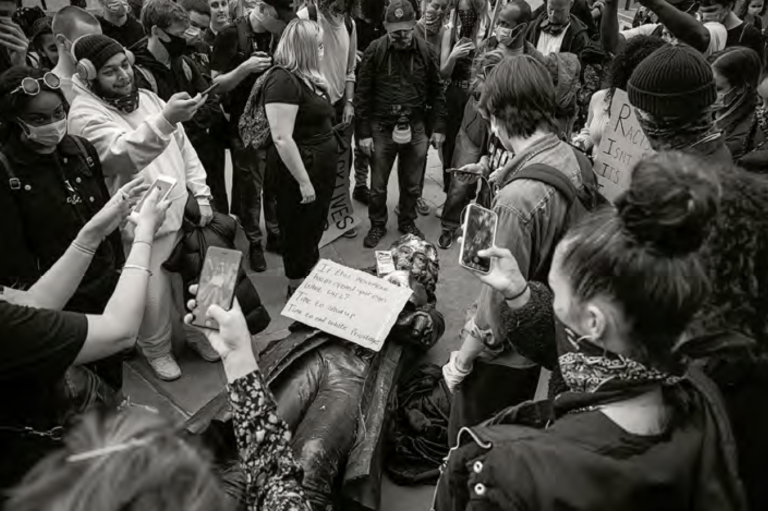
The crowd surrounding the fallen statue of slave trader Edward Colston during the Black Lives Matter protest in Bristol, UK. The sign reads: “If this movement hasn’t opened your eyes, what will? Time to speak up. Time to end white privilege.” Photo by Keir Gravil, under a CC BY-NC-SA 2.0 license.
Footnotes
- Editor’s note: The monument was partially removed in December 2023.
- Площад СЛАВЕЙКОВ (2014): ‘Десет млн. лв. за най-скъпия паметник у нас – на Съветската армия.’ [SLAVEIKOV Square (2014): ‘Ten million leva for the most expensive monument in our country – The Soviet Army War Memorial’]. Available at: https://www.ploshtadslaveikov.com/deset-mln-lv-za-naj-skapiya-pametnik-u-n/ (in Bulgarian).
- More information available at: https://spark.adobe.com/page/hJmFRkXKLl72C/ (in Bulgarian).
- Площад СЛАВЕЙКОВ (2014): ‘Какво да правим с паметниците’ [SLAVEIKOV Square (2014): ‘What are we going to do with the monuments’]. Available at: https://www.ploshtadslaveikov.com/kakvo-da-pravim-s-pametnitsite/ (in Bulgarian).
- Площад СЛАВЕЙКОВ (2014): ‘Гняв в Русия от поругаването на съветски паметници у нас’ [SLAVEIKOV Square (2014): ‘Anger in Russia over the desecration of Soviet monuments in Bulgaria’]. Available at: https://www.ploshtadslaveikov.com/gnyav-v-rusiya-ot-porugavanitesavetski/ (in Bulgarian).
- Площад СЛАВЕЙКОВ (2014): ‘Скулпторът Крум Дамянов: Бих набил този, който маца паметниците’ [SLAVEIKOV Square (2014): ‘The sculptor Krum Damyanov: I would beat the one who touches the monuments’]. Available at: https://www.ploshtadslaveikov.com/ skulptorat-krum-damyanov-bih-nabil-toz/ (in Bulgarian).
- Площад СЛАВЕЙКОВ (2014): ‘Няма да махат Паметника на Съветската армия, сменят името му’ [SLAVEIKOV Square (2014): ‘They will not remove the Monument to the Soviet Army, change its name’]. Available at: https://www.ploshtadslaveikov.com/nyama-da-mahatpametnika- na-savetskata/ (in Bulgarian).
- See at: https://www.facebook.com/ChristoandJC/posts/10158350281004491

